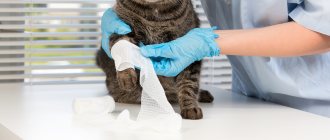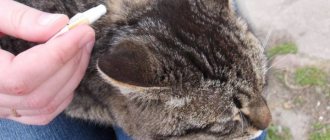The largest medical portal dedicated to injuries to the human body Consultation with a doctor
Stray animals or pets living on the street often have a wilder disposition and can attack people in case of danger, during play, etc. Quite often the wound becomes infected, but dangerous diseases accompanying injury can be prevented.
Let's take a closer look at what to do if you are bitten by a street cat in order to prevent the development of life-threatening consequences.
If you know what to do when an animal bites you, you can avoid many serious consequences.
- Prevention of rabies
Why are cat bites dangerous?
Cat bites can provoke severe infectious processes that affect the skin and fatty tissue. The danger also lies in infection with viruses, the worst of which is the pathogen that contributes to the occurrence of rabies. This disease inevitably leads to death.
A cat bite can cause deep tissue infection
The saliva of a pet contains a large number of bacteria, which during a bite get deep into the tissue, since the cat’s teeth are long and sharp. Pathogenic microflora provokes the appearance of purulent processes, which lead to edema and the formation of infiltrates. If you do not consult a doctor in time and do not carry out antiseptic treatment, the infection spreads to surrounding tissues, increasing the risk of dangerous complications for a person’s life.
A cat bite can lead to serious inflammation
In addition, there is a high probability of damage to nerve endings during a bite, which will provoke a further deterioration in the mobility and sensitivity of the limbs. If after an incident with a cat you feel numbness in the skin, it is recommended to immediately go to the emergency room.
Attention! Cat bites that do not heal for a long time indicate a serious infectious process in the tissues.
What happens if a cat bites - video
Reason for attack
Street cats can be more affectionate than purebred apartment pets, so you should not be biased towards them. However, self-defense instincts often work in such a way that a person receives scratches and bites.
A bite can be caused by the following factors:
- human aggression, animal self-defense;
- interference in the cat’s personal space;
- fear;
- territory protection;
- trying to pet a cat;
- character traits of the animal;
- protection of offspring;
- a person's attempt to separate fighting animals;
- unpleasant sensations (for example, if you pull a cat’s tail);
- passion for the game;
- disease.
If you are bitten by a cat on the street for no obvious reason, you should seriously think about the need for rabies vaccination, since such behavior of the animal may well be provoked by this dangerous disease. The cost of delaying seeking help is death in 100% of cases.
First aid
What to do first:
- Rinse the wound under cool water for 5–10 minutes. Then treat the bite site with laundry or tar soap. After one minute, rinse thoroughly.
- Soak a cotton pad in hydrogen peroxide, Miramistin or Chlorhexidine. After this, treat the affected area and rinse again under cool water.
- The edges of the wound should be lightly lubricated with iodine or brilliant green; alcohol can also be used for these purposes, but under no circumstances should the bleeding surface be treated with the listed agents.
- At the last stage, you need to apply a bandage using a wide bandage.
Hydrogen peroxide can be used to treat a cat bite wound.
If there is minor bleeding, no measures need to be taken. In this way, all pathogenic microorganisms that could enter with saliva are naturally released. However, if the bleeding is severe, it is recommended to wash the wound according to the algorithm described above and bandage it tightly.
Attention! It is not recommended to apply various healing creams and ointments to a fresh wound. They can only be used after consulting a doctor.
First aid after an incident - video
How to tell if a cat might bite
The cat warns before the attack
When a pet is tired, angry, irritable or playing aggressively, it always shows before attacking; just watch it and avoid being bitten.
Important: a cat always warns of its intention to bite; you just need to catch its signals.
Signs that your cat may bite now:
- Wags its tail from side to side from the base. Since childhood, people have known that a cat shows dissatisfaction with its tail, and a dog, on the contrary, shows joy and greeting. Therefore, if you find that your cat is wagging its tail dissatisfied and actively, you should not provoke it into aggression, since the next step may be a bite.
- Raised one or both paws up . She hasn't done anything yet, she warns that she is ready to defend herself. And if you ignore this, you can get your well-deserved portion of bites.
- Hisses. Another warning signal, in the form of a defensive reaction. She seems to be saying: “Leave, otherwise I will attack.”
- She arched her back and raised her fur. The cat is about to attack, and then teeth and claws will come in. It is advisable to avoid conflict, get away from the animal, and maybe isolate yourself in another room for a while.
- Ears back and dilated pupils also indicate the animal’s excited state and if provocation or stress continues, there is a possibility that it will show aggression.
- During the game, she grabbed her arm/leg with her paws . Captured prey - bite. A simple rule for mustachioed pets. It is advisable to stop playing or prevent the bite.
All actions of the animal are precautionary in nature, so a bite can always be avoided.
When to see a doctor
When you need specialist advice:
- with severe bleeding that does not stop after applying a bandage;
- if numbness is felt in the affected area;
- in the presence of a laceration;
- if body temperature rises and general health worsens;
- when severe swelling forms in the bite area.
Severe swelling in the wound area after a cat bite is a reason to consult a doctor
You should also consult a doctor if pulsation is felt in the affected area and the skin becomes warm. In addition, consultation with a specialist will be required if pus and inflammation appear. The doctor will also help if the wound does not heal for a long time.
Attention! Consultation with a specialist is mandatory if the animal is outdoors or hunts rodents.
Medicines to relieve swelling
If the hand is swollen significantly and over a large area, extending far beyond the area where the cat bit, it is necessary to use antibiotic therapy. Such treatment after a cat bite will stop the progression of inflammation and destroy pathogenic bacteria. In case of severe tissue swelling, external remedies are not enough and oral antibiotics are indicated. If it is possible to visit a doctor, then the site of inflammation is injected with antibiotics. In this case, the effect of the drugs will be observed in maximum concentration directly in the affected tissues.
For internal use, if a cat has bitten, broad-spectrum antibiotics are often prescribed, to which all bacteria that enter the wound from the cat’s mouth along with its saliva are sensitive. Preference is given to the following means :
- amoxicillin,
- lincomycin,
- clavunate,
- ceftriaxone,
- ciprolet.
© shutterstock
Take the medicine for at least 5 days and no more than 10. In most cases, a week of therapy is enough to relieve the inflammatory process and eliminate swelling of the hand after a cat bite. In severe cases, when the arm is swollen and painful, antibiotics can be administered through injections, but in such a situation the patient is usually hospitalized, since there is a serious threat to his health and life.
Treatment for cat bites
Treatment of a wound after a cat bite is complex. In this case, first of all, you should contact a specialist who will administer the vaccine against rabies and tetanus. This measure is necessary if the animal is outdoor or often walks and has contact with other pets, as well as rodents. If the vessels are severely injured, the doctor may recommend suturing the wound.
To speed up the healing of damaged tissues, it is necessary to combine medicinal treatment methods with traditional methods.
Drug therapy
Complex drug therapy can reduce the risk of complications and speed up the healing process of damaged tissue several times. To prevent suppuration, antibacterial medications are most often prescribed, such as: Amoxicillin, Amoxiclav, Ceftriaxone and others. These drugs are used for up to 5–7 days in doses recommended by the doctor and depending on the nature of the wound.
Amoxiclav destroys pathogenic microflora
To speed up healing, Levomekol ointment is also used, which has an anti-inflammatory and antibacterial effect. The drug prevents wound suppuration and is used at least 2 times a day for a week. After lubricating the affected area, it is important to apply a gauze bandage. Also, Vishnevsky ointment is often used for treatment, which quickly relieves the inflammatory process.
Levomekol has an anti-inflammatory effect
At the last stage of therapy, D-Panthenol cream is used, which helps restore the skin and prevents scar formation. It is recommended to use this remedy 2-3 times a day for 10 days. You should not bandage the bite site.
D-Panthenol accelerates tissue regeneration
Attention! Under no circumstances should you cover the affected area with adhesive tape, as this can increase the risk of wound suppuration.
One day my mother was severely bitten by a domestic cat. The wounds were so deep that the hand was swollen. I had to seek help from a doctor who prescribed painkillers and antibacterial agents. The wounds on the arm took about a month to heal, and the treatment was lengthy. The tumor subsided gradually, and the bite marks themselves took a very long time to disappear. It’s good that there were no scars left because my mother used a healing cream.
Folk remedies
Effective folk recipes:
- Tincture of calendula. It is best to purchase it in a pharmacy in ready-made form. This product can be used to treat the edges of the wound, but not the bite site itself. Calendula has an antibacterial effect and eliminates the inflammatory process. It is best to treat fabrics using a cotton swab 2 times a day for 3–4 days.
- Chamomile decoction. You will need 2 tbsp. l. dry raw materials, which need to be poured with 400 ml of boiling water and boiled over low heat for 20 minutes. Then let it brew for another hour. Then filter the liquid through gauze and use it to wash damaged tissues 2 times a day for a week. This remedy will speed up the healing process and prevent suppuration.
- Sage tea. You will need 1 tbsp. l. raw materials, which needs to be poured with 300 ml of boiling water and left for 2 hours. Then strain the liquid and use it to wash the bite site 2-3 times a day for a week. The infusion has an anti-inflammatory effect and produces an antiseptic effect.
Attention! Traditional methods of treatment do not replace drug therapy, so these remedies can only be used in combination with medications.
Ingredients for traditional medicine recipes - photo gallery
Calendula tincture has an antibacterial effect
Sage produces an antiseptic effect
Chamomile eliminates inflammation
A remedy to relieve the condition before visiting a doctor
When, after a cat bite, the hand is very swollen, and according to all signs it is necessary to seek medical help, but for some reason it has to be postponed, the patient needs to use a special bandage to improve the condition, which will slow down the spread of the inflammatory process. The use of such temporary treatment is possible for no more than 2 days and only as a last resort before visiting a surgeon.
To improve the patient’s condition, it is necessary to apply a bandage to the damaged area, previously washed with laundry soap, heavily soaked in ointment with the antibiotic levomekol and alcohol, or in extreme cases, vodka. During the day, the bandage should be re-moistened with alcohol regularly. It promotes the opening of pores and, as a result, the rapid penetration of the ointment into the tissue. The bandage also reduces heat at the site of swelling. The sore arm must be rested and secured in a sling.
Possible complications
The most dangerous complication that can occur after an animal bite is blood poisoning. This is possible when the infection gets into the deep layers of tissue. Sepsis can be fatal, so neglecting treatment is not recommended. Another serious complication is infection with tetanus and the rabies virus. Both pathologies are not amenable to therapeutic correction. In addition, tendons and muscles may be injured, resulting in limited motor activity of the affected limb.
Attention! With advanced purulent processes, mandatory drainage and rinsing of the cavity is required. To avoid such a consequence, it is important to begin antiseptic treatment immediately after the incident.
Why do cats bite their owners?
Often the reason for an attempt on your life is the release of adrenaline, but not by your cat, but by you. Are you so deeply upset that you cry your eyes out? Have you lost your nerves and are you starting to scream? Are you unable to cope with an important task and are tearing out your vest and hair in a panic? Be ready to attack!
Cats are very sensitive to the psycho-emotional background in the house and the state of the people living in it. And if the cat is also very attached to its owners (and this most often happens!), then it is “infected” by the negativity that spills out of you.
Not knowing what to do with the “gift” that has fallen on her, the cat does what seems most acceptable to her in the current alarming situation - she bites the first one that comes to her hand, excuse me, on the tooth.
Sometimes the cat tries to calm you down with a bite, to distract you from thoughts that, in your cat’s opinion, are causing you to behave inappropriately - you cry for too long or, conversely, you can’t calm down from choking laughter. The cat does the same thing a person would do if he caught another in a hysterical state: sharp unexpected pain or sudden fear causes the person’s nervous system to instantly mobilize. A cat bite causes exactly this reaction and you, distracted by the pain, calm down.
Prevention measures
Prevention rules:
- Be careful when playing with cats. Try to avoid bites and scratches.
- Do not touch street animals unless you are sure that they are friendly. If a cat hisses, then you should not tempt fate.
- If your pet bites you, you should immediately wash the wound with soap and treat it with any antiseptic.
- At the slightest suspicion of an inflammatory process, immediately consult a doctor.
- Do not try to heal deep wounds after a bite yourself.
- Be sure to get vaccinated against tetanus. Such an injection will protect against a terrible disease that can be transmitted by an animal, especially a stray one.
- When playing with your pet, do not expose your face to it.
Attention! You should never try to separate two fighting cats with your bare hands, otherwise you may suffer serious injuries.
Wounds after a cat bite do not always go away on their own and in about 40% of cases such incidents provoke the development of an infectious process. It is important to immediately treat the damaged surface to reduce the risk of consequences. If the cat is not a domestic cat, then it is imperative to seek the help of a specialist.
Why do cats bite?
A cat doesn’t always bite when it’s angry, but also when it’s playing.
A domestic cat, no matter how cute and affectionate it may be, is still a predatory beast. The instincts and habits of mustachioed predators have not gone away. Therefore, the bites of furry animals are a natural and genetically inherent reaction, both positive and negative. A cat bite can happen for a variety of reasons.
- Aggression: defense or attack. In this case, the animal uses its sharp fangs to neutralize the enemy. It can be either a person or another animal. If a cat senses danger, it may bite the owner or other residents of the house. Since a cat is a small animal, it has no choice but to expose its sharp teeth.
- A game. During play, small kittens and adult cats can also bite a person or other animal. As a rule, during the game they calculate their strength. But small, teenage kittens are not fully aware of the full power of their jaw and even in play can cause serious injury.
- Irritation. Abundant caresses of the animal can also provoke a portion of cat bites. Thus, the animal demonstrates that she is experiencing hostility and irritation.
- Painful condition. Cats may bite when they are in pain. They become irritable and aggressive. If the animal is touched at this time, including a sore spot, it may bite, using the bite as a means of protection from pain.
- Fear. An animal experiencing fear and insecurity may also bite in an attempt to protect itself. This can happen when caring for it: trimming its claws, bathing, medical procedures, etc., and also if the cat has a mistrust of the person, the owner, associated with past negative experiences.
- Reaction to smell. Cats may bite in response to smells such as garlic, citrus fruits and vinegar.
But no cat bites without a reason. To avoid such behavior and danger from the animal, you should not provoke it, frighten it, or use physical or mental violence; it is necessary to stop aggressive games from childhood so that the kitten calculates its energy when biting.
Important: The sharp fangs of your beloved cat can leave deep and dangerous wounds
Is the cat sick?
The cause of “sudden” aggression with mutilation by biting can be triggered if the cat is sick. For example, an otitis media or hematoma can cause an aggressive reaction to your hand when you accidentally touch a cat’s ear or head; a subcutaneous abscess formed on the body or an injury invisible to the eye. If this behavior was not typical “before today,” take the animal to the doctor.
The reason that the cat has become aggressive may also be a disorder of the nervous system - neurosis. This disorder occurs when nerve structures are overstrained, leading to disruption of the physiological activity of the brain. Simply put - stress, obsessive fear, overwork, intoxication, endocrine disorders, vitamin deficiency and infectious diseases. A visit to the doctor is mandatory, because... it will be necessary to conduct a series of studies in order to eliminate the cause of the neurosis and exclude such a dangerous acute infectious disease as rabies.











